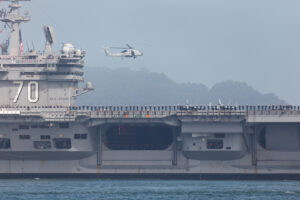AFFF Exposure in the Navy: Were You Exposed to Firefighting Foam?
Aqueous film forming foam (AFFF) is a fire-extinguishing foam that is used to put out fuel fires, especially those involving aircraft. AFFF are made using per- and polyfluoroalkyl substances (PFAS), which have been linked to various cancers and other adverse health outcomes. The Assistant Secretary of the Navy notes that scientists have identified as many as 4,700 individual PFAS compounds and about 600 PFAS used in industrial and consumer products.
If you believe that you have suffered adverse health consequences as a result of PFAS exposure while in the Navy, it’s critical that you contact an attorney as soon as you can. At Keefe Law Firm, we know how to get injured victims the compensation they deserve. We’ll review your case for free and will never collect fees unless we win your case. Call us today to schedule your free case evaluation.
AFFF Use in Navy Firefighting
For more than a half-century, the Department of Defense required the use of a firefighting foam made with PFAS, or AFFF, and over 700 military sites in 50 states were suspected to be contaminated with PFAS. What’s more, AFFF firefoam has been frequently used on Navy aircraft carriers due to its effectiveness on fires caused by aviation fuels and ability to keep these blazes contained relatively quickly.
PFAS exposure is associated with certain kinds of cancer, reproductive and developmental harms, and immune harms. In January 2023, the United States Department of Defense released new requirements for the firefighting foam it uses to put out jet fuel fires.
The same law requires the United States Department of Defense to stop buying PFAS-based foams by October 1, 2023, and stop using them entirely by October 1, 2024. The update requires firefighting foam suppliers to certify that there are no intentionally added PFAS in their products and requires foam testing to ensure no PFAS are detected.
This new specification could have major impacts on airports. While many airports already use PFAS-free foam, the Federal Aviation Administration (FAA) requires American civilian airports to meet the military’s standards.
Congress required the FAA to allow airports to switch to PFAS-free foams by 2021, but the agency kept its standards pegged to the military standards and effectively prevented airports from switching. The updated specification will eliminate the barrier.
Possible Cancers Navy Personnel May Suffer
Many different health organizations have identified a link between some kinds of PFAS chemicals and an increased risk of cancer and other health problems in military firefighters. PFAS are also known as “forever chemicals” because they are a class of chemicals used to make products grease proof, water-proof, stick-proof, and stain-resistant.
The result is that PFAS can remain in a person’s system for many years beyond original contact, and the chemicals may develop over time and cause health problems. Some of the ailments that have been linked to PFAS exposure through scientific studies include:
- kidney cancer
- liver cancer
- testicular cancer
- thyroid disease
- thyroid cancer
- ulcerative colitis
Common Kinds of AFFFs
AFFFs are generally low-expansion foams that have expansion ratios of less than 20 and can quickly cover large areas, but there are also medium-expansion foams with expansion ratios of 20–100 and high-expansion foams with expansion ratios of more than 200 up to 1000. Class A foams are used for fighting wildfires while Class B foams are designed for class B fires relating to flammable liquids.
Class B foams may be synthetic or protein based. There are different methods for applying foam based on the type of foam being used.
Common types of AFFFs include:
- Buckeye 3% Mil Spec AFFF by Buckeye Fire Equipment Company
- ChemGuard AR-AFFF 3% x 6% Foam by Chemguard, Inc.
- FireAid by Fire Service Plus, Inc.
- Light Water AFF by 3M Company
- THUNDERSTORM W833A 3×3 AR-AFFF by Williams Fire & Hazard Control
Companies involved in the manufacturing and distribution of AFFFs have included:
- 3M Company
- Ansul®
- Chemguard, Inc.
- DuPont
- Dynax Corporation
- National Foam
- Tyco Fire Products
Military firefighters suffering from a cancer caused by exposure to PFAS may file a AFFF lawsuit firefighting foam cancer claim to recover adequate compensation for covering the many costs associated with their recovery. If you believe you have a claim, you want to be sure that you have an experienced attorney from Keefe Law Firm on your side.
Call Our Navy AFFF Firefighting Foam Lawyers Today
If you are suffering any kind of adverse health consequences to having used PFAS or AFFFs in fighting fires, you should make sure to retain legal counsel as soon as possible. Keefe Law Firm is currently assisting current and former navy personnel, other military personnel and firefighters throughout the country.
Our firm has been in existence for more than 100 years, since 1919, and we provide a wide range of business and personal services to our clients. You can call 888-416-0685 or contact our firefighter cancer risk attorneys online to receive a free consultation.
